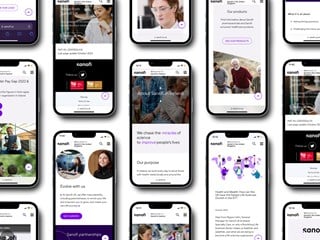August 22, 2022
The COVID-19 pandemic unsurprisingly impacted global healthcare. One of the impacts was that chatbots run on Natural Learning Processing emerged as a key channel of communication.
The potential of chatbots is currently underutilized. Natural language search – the little search bar that takes complete questions and answers them with smart results – is also growing in popularity. Both techniques are perfect for consumers who are looking to “have a conversation” rather than read through lengthy research. They offer friendlier and lower friction ways to engage with healthcare systems. What used to be an underperforming “add-on” in digital healthcare is now crucial and supports diversified types of communicational experiences.
Chatbots are like a genie in a bottle, but with a pre-written script.
Chat is a more limited version of a call-center conversation, with prefabricated responses and smart search results. A good chatbot presents links to web pages or provides relevant responses sourced from common data from the website or call center. This ensures consistency in answers across platforms – chatbots, website, call center and more.
Natural Language Processing – or NLP – is a form of machine learning that makes an educated guess on what the user is talking about through a multi-step process that progressively narrows down its guesses. If the process does not provide a satsifactory response, the user gets a "bail-out" where they can then communicate with a human at a call center, for example.
Chatbots use NLP to discern “intents," which refers to the user’s intention or need, like scheduling a doctor’s visit or getting Covid-19 information. Think of these intents like a chatbot's map, which automatically and conversationally guides users to the information they need or toward a transaction. Carefully built chatbots, with support for multiple intents, can potentially replace web browsing and in some cases web forms.
Chat presence on a website can be very versatile. Most chat platforms can be integrated in a more sophisticated way. For example, the chatbot can be aware of what part of the website the user is visiting, assuming they have accepted tracking. It’s no Swiss Army Knife, but a chatbot can have so many creative uses. As long as you build appropriate support, the sky is the limit!
Think of Natural Language search as your nerdy older brother who always answered your “Why” questions as a kid.
Natural Language search uses NLP like chatbots to hone in on relevant results. However, Natural Language search is less tightly programmed than chatbots; it simultaneously has more room for error and a broader reach to all subjects. Unlike chatbots, there are no pre-programmed or highly focused intents.
For example, if you search “Where is the parking garage for the Cancer Center”, the search results will be links that direct you to the most relevant web pages to answer your question. Users generally like to formulate their searches as questions, as if they are having a conversation. Natural Language search’s wider reach allows people to use this kind of comfortable wording and get helpful results.
An example: Some platforms, like Yext Answers, are AI-powered. Rather than linking to web pages, Yext Answers employs Natural Language search to provide direct answers that are modeled in the Yext master data management system.
The user search data from Natural Language search is telling and can help companies further formulate user-centric content. This is an improvement over conventional search without creating a whole new paradigm of interaction.
Not all chatbots and NLP platforms are created equally. So how do you pick one?
Dedicating lots of training time for healthcare chatbots is what sets vendors like Loyal Health and Gyant apart and gives them a huge edge over others. Training the NLP for different areas and healthcare intents allows chatbots to accurately understand what the user is talking about.
Features and integrations are also differentiators. Chatbots need to have a usable backend for teams and companies to be able to develop an efficient practice around them. They also need to be highly integrated with outside data sources to make sure the facts in their answers are up-to-date and accurate. Poorly integrated data represents a common pain point for chatbot platforms.
Going a step further, “enterprise conversation management” go a step further than chatbot-only platforms. They use the same conversation logic and facts across multiple other channels and can include voice, telephone automation and more. Cognigy, an enterprise software provider for conversational AI automation, is a great example of a platform that aligns all the chat and voice channels at once.
What about developing a chat practice?
Strong conversational design and a vivid brand experience are the secret sauce. Responses that fit a brand’s tone while emotionally connecting with, surprising, and delighting the user are all important factors in developing a chat practice.
As for the nitty gritty, master data management is essential to securing the relationship between the chat and the facts. Those integrations need to be governed and long-lasting. Chat experiences require frequent attention, with people who are responsible for monitoring how accurate and user-friendly the responses are as the chat evolves over time.
Who takes responsibility? Resources are often tight in consumer healthcare and there is often one person that owns content strategy and one person that owns user experience. Either of these roles can take on a leadership position and own the chat practice, given available time. Despite all the data integrations, the role of owning the chat practice is most tightly aligned with user experience, not just technology.
Need support? We can help.
We know how to get a great chat practice on the right platform. Valtech Health implemented a loyal chatbot for Memorial Healthcare System (MHS), which included an integration with MHS’s master data management system to surface provider and location data.
We also supported the University of Maryland Medical System, Christus Health and many others in customizing and updating their Covid-related chatbot content. This was crucial for keeping constantly shifting messaging accurate and up to date, like when there was a pivot of information from social distancing guidelines to vaccine access, for example.
Valtech Health can support healthcare organizations in providing a good chat and natural language experience for their users. We can consult on strategy for chatbots, from defining key business goals all the way to implementation. This includes complex integrations, launch, and ongoing optimization. Once the platform is on the market, we can adjust the approach as user data gives us more insight into how the chat is being used and business goals change over time.






